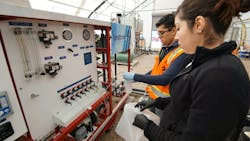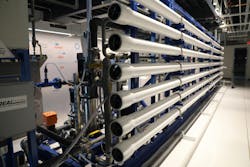Water is the Foundation of Life: Using Indirect and Direct Potable Reuse to Address Water Scarcity
Water is the foundation of life, economies, and civilization. The value of water extends far beyond drinking and agriculture. There are countless hidden uses of water such as making jeans, a T-shirt, a computer or cell phone, an automobile, food, plastic, electricity, timber, and nearly everything else that humans need and use in daily life.
Competing for shared water sources
California touts the fifth largest economy in the world, where manufacturing, industry, tech, agriculture, environmental, residential, and commercial interests all vie for a limited water resource with unequivocal importance.
Imagine a bowl of water with straws in it. The bowl represents all the available water needed to satisfy the thirst of California. The straws represent both the vehicle to access the water and the usage of water for each interested party. As witnessed during the last prolonged drought, climate change impacts our ability to meet everyone’s needs and if that bowl of water dries up, it leaves all parties parched and unable to sustain themselves.
When atmospheric rivers pummel the state and fill up the reservoir network, a collective sigh of relief is palpable. As recently as 2022, the state experienced its worst drought in history. Some water agencies were forced to initiate water conservation mandates to quell the use of outdoor irrigation, while the state grappled with this dwindling resource. This was as close to a modern day, real life, “Tragedy of the Commons,” or “Day Zero Water” scenario. Thankfully, that was avoided. What has been lacking locally, regionally, and within the state is water resource resiliency.
California leads in water resiliency utilizing recycled water
While work remains, California is a global leader in the use of recycled water for non-potable and potable water reuse. On December 18, 2023, the California State Water Resources Control Board (SWRCB) unanimously adopted regulations for direct potable reuse (DPR) as an option for water agencies to localize resources and diversify water portfolios — providing an additional tool for water managers across California. The regulations allow for treated wastewater to be purified beyond conventional recycled water standards then directly introduced into a municipal water supply without an environmental buffer.
Indirect potable reuse (IPR) is currently a more widely used process in California and globally. In California, IPR has been supplementing its water supplies since the 1960s. The current standard IPR “treatment train” consists of microfiltration, reverse osmosis, and ultraviolet light/advanced oxidation, which produces purified recycled water, or “Pure Water.” The IPR process typically requires a log removal of at least 12 (virus), 10 (Cryptosprodium), 10 (Giardia) and potentially higher depending on various factors.
After treatment, purified water is devoid of pathogens (bacteria, protozoa, viruses), chemicals (PFAS, pharmaceuticals, personal care products, microplastics), minerals, and salts. While meeting all water quality (and health) standards, this water is then placed into an environmental buffer such as a reservoir or groundwater basin, per IPR regulations. The water must be mixed with other water sources for two to six months before it can be introduced into the drinking water system.
In some cases, it is treated again depending upon the environmental buffer. Mixing the purified water within an open surface water reservoir can result in added organics and microorganisms, necessitating treatment before it is introduced into the distribution system. Mixing the purified water within a groundwater basin may reduce the quality of the purified water, requiring removal of iron and manganese (for example) before serving the extracted groundwater to customers.
Environmental buffer
The use of an environmental buffer such as a reservoir or groundwater basin has cost implications such as pumping, transportation, and treatment. However, the concept behind an environmental buffer is that it allows ample time to address any inadvertent shortcomings in the treatment process before the water is introduced into the drinking water system. The other major benefit of an environmental buffer is the ability to store water for the future when it is needed.
IPR vs. DPR
IPR requires a chief operator with at least a drinking water or wastewater grade 3 treatment certification and an advanced water treatment grade 3 certification at start up. Within a few years of operation, a grade 5 drinking water or wastewater certification and grade 5 advanced water treatment certification is required. IPR treatment facilities do not need to be manned 24/7, but rather are operated 10 to 12 hours a day depending on the level of instrumentation, automatic shut-down capabilities, etc.
In contrast, DPR is a much more stringent treatment process with more barriers and does not rely upon the use of an environmental buffer. A higher log removal is required — typically 20 (virus), 14 (Giardia), 15 (Cryptosprodium). With DPR and no environmental buffer, greater certainty is required for removing contaminants, which means additional treatment processes and greater reliance upon real-time monitoring.
“The DPR treatment process is based upon scientific, data driven facts where public health is the most critical component to its usage and success,” said Rosario Cortes, manager of regulatory affairs for WateReuse California. “The regulations that were passed ensure the water is clean and pure. The newly adopted DPR regulations are extremely thorough and ensure public safety and trust throughout the state. This water is safe to drink.”
DPR treatment includes the addition of biologically activated carbon (BAC) and ozonation as pre-treatment to ultrafiltration, reverse osmosis, and advanced oxidation – noting that this requirement is if the purified water will be 10% or more of a blended drinking water supply. If the purified recycled water is less than 10% of the drinking water supply, these additional processes are not necessarily required; however, the higher log removal is still required, which does require the addition of new disinfection barriers such as ozone.
For DPR, certification requirements are similar to IPR, but the chief operator must have a drinking water treatment certification, which cannot be substituted with a wastewater treatment certification. DPR treatment facilities must be staffed with a certified operator at all times when the treatment plant is running.
While both IPR and DPR deliver pure water for drinking water systems — purer than any other known source on the planet — both strategies have their place. Potable reuse is a term that is well acknowledged and understood in California by the legislative body, the public, and other utilities. What DPR affords communities is another option for localizing water sourcing even when environmental storage is not an option.
“As water and wastewater agencies, we have pivoted from the mentality that treated recycled water is a waste product to recognize its value as a resource that is resilient to the impacts of climate change and natural disaster,” said David W. Pedersen, general manager of Las Virgenes Municipal Water District and administering agent for the Las Virgenes – Triunfo Joint Powers Authority. “Because of erratic and unpredictable weather patterns, DPR provides an additional option for water agencies to create a local water source where a consistent supply is ensured.”
With DPR, ozonation and BAC can add capital, operational, and maintenance costs to the treatment process, but DPR may be the only option for an agency if a surface water reservoir or groundwater basin is not available. Even if an environmental buffer is available, DPR could potentially be less expensive than IPR, but a cost comparison and feasibility analysis would need to be conducted.
Conclusion
Both strategies have their place and will become an increasingly important and reliable source of high-quality drinking water, while traditional supplies become increasingly less reliable.
Water is the foundation of life, and quite literally everything that humans and the planet’s flora and fauna need to survive. DPR helps to strengthen the certainty that clean, fresh, safe potable water will consistently flow from the tap and that the needs of the economy and the environment can be met.
About the Author

Joe McDermott, PE
Joe McDermott is a registered professional engineer in the State of California with over 25 years of experience in the civil engineering profession. He holds both a Bachelor’s degree in engineering and a Masters degree in public administration. Joe spent much of his career with the City of Ventura delivering designs for a variety of water infrastructure projects. Joe later spent several years as the Assistant General Manager for the Ventura Water Department, providing oversight for water and wastewater operations. Starting in early 2018, Joe began working with Las Virgenes Municipal Water District, where he is now the director of engineering and external affairs. He is no stranger to managing operations through droughts and aligning customer demands with available water supplies.

Mike McNutt
Mike McNutt joined Las Virgenes Municipal Water District (LVMWD) in 2017 as the public affairs and communications manager after spending time at Palmdale Water District and the Metropolitan Water District of Southern California, immersing himself in California water and its unique complexities. Born and raised in Columbus, Ohio, Mike received degrees in environmental science and communications from Ohio State University, where he remains active in the college of environmental science alumni group.
Embarking on a career in public service post-graduation he worked for various community organizations, elected officials and government agencies throughout Ohio gaining valuable experience in emergency communications, public health outreach and community services.
At LVMWD Mike has used these experiences to respond to emergencies such as the 2018 Woolsey Fire, COVID-19 pandemic and generational drought while developing both internal and external communication strategies rooted in a commitment to transparency, equity, innovation and an ethos of community first.
In 2023, Mike and his team were awarded the Frank Potter Cowan Crisis Communications Leader Award from the California Association of Public Information Officials for their work on drought outreach, media relations, and emergency response.
Mike serves the LVMWD on the diversity & inclusion committee, the community as the chair of the board for the Calabasas Chamber of Commerce, the water industry as the chair of the California Association of Sanitation Agencies Communication Committee and a member on their program committee, and is the proud owner of a rescued greyhound named Wendell and supporter of SaveGrey.org.


